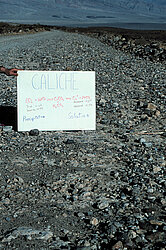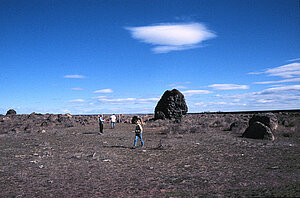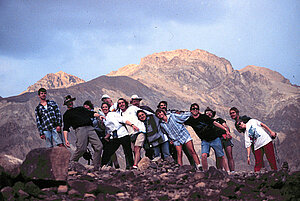Friends of the Pleistocene

Death Valley Field Course 1994
GEOL 495 Death Valley Field Course1994
Chapter 20. Applications of Pedology to Geomorphological Interpretation
Introduction. Pedology is the subdiscipline of soil science focused on the formation (genesis), morphology, and classification of soils "as natural landscape bodies" (Soil Sci. Soc. Am., 1992). This definition implicitly suggests that pedology and geomorphology (the study of landforms) are intimately related. The purpose of this paper is to provide a framework that illustrates how application of pedologic concepts and evidence can increase an understanding of Quaternary and Holocene geomorphology .

Columbia Plateau/Channeled Scablands Field Course 1998
GEOL 495 1998
Columbia Plateau/Channeled Scablands Field Course
Chapter 5. Volcanic ash-physical, edaphic, and chronologic significance
in the pacific northwest
Introduction. Disastrous effects of volcanism are obvious to those unfortunates too near an event in time and space. Distance in both dimensions however, provides advantages for agricultural pursuits. Northern Idaho and much of the pacific northwest are blanketed by a thin veneer of ash due to Holocene volcanism that significantly enhances soil productivity compared to local soils developed in parent materials lacking ash. Benefits of ash are also realized in engineering applications, some far older than most people recognize. The focus of this paper is on the physical, chemical, and mineralogic properties of ash that are responsible for the unique behavior of this material in agriculture and engineering. The excellent basis for ash as a time-stratigraphic marker, and a few caveats, will also be discussed.

Death Valley Field Course 2000
GEOL 495 Death Valley Field Course 2000
Chapter 22. Hard rock pedology: silica cemented soils of arid regions
Introduction. Soils are overlooked and undervalued as intrinsic and essential components of terrestrial ecosystems. They can be used as environmental indicators because they integrate the lithosphere, the biosphere, the hydrosphere, and the atmosphere, through the course of time. Roy Simonson, a famous soil scientist from North Dakota said, "the profile carries within itself a record of its history for those who learn to read it" (Simonson, 1957). The "book of soils" should be on the required reading list for all earth scientists! The GEOL 495 Death Valley Field Course will acquaint all participants with a fascinating set of landscapes. Soils, representing a staggering range in age, blanket those landscapes, and regardless of ones "disciplinary specialty" in geosciences, an investment in soils will provide many dividends in terms of mineralogy, weathering, and geomorphology. There are two major cemented horizons in arid region soils. Soils cemented by calcite (CaCO3) are nearly ubiquitous and have been extensively studied (calcic and petrocalcic horizons). Soils cemented by silica are not as common, yet have intriguing genesis, and a few recent studies suggest there is more to be learned. This paper describes the genesis, properties and implications of soil horizons cemented by silica produced from surficial weathering processes.


Joint UND/NDSU Hawaii Field Course 2002
GEOL 495 Joint UND/NDSU Hawaii Field Course 2002
Chapter 15. Soils of Hawaii: the "sexy"-oxides
Prologue. Somewhere near the upper slopes of the Waianae Range the ethereal spirits, Vasily Vasilyevich Dokuchaev and Hans Jenny, are engaged in a yet another of their common spats, on which of the five factors of soil formation are most critical to the development and nature of the soils in their adopted earthly haunts-the Hawaiian Islands. "Duke, tell me you're kidding, how in Heavens name (he looks up, lovingly) can you possibly think parent material is more important than the climate?" "Look at this place, we have the greatest extremes in precipitation anywhere on the planet and you can sit here and maintain that differences between the Hilo and the Haiku soil series are just based on the relative contents of mafics in the host rock- why that's hogwash! "Hans, I wish you could get your head out of the dirt long enough to recognize a bit of subtle diplomacy when you hear it- didn't you get the memo this morning?" "Don't you remember how long we had to fight to finally have pedology emerge from under the sway of those infernal geologists?" "I just want to make them "feel" like it is most important factor. "Put on your distance glasses you old windbag, can't you see that fresh batch of geoscientists' crawling their way north through that nasty little ground blizzard to Winnipeg. They will be here in a flash-let's see which factors they think are most important."
Introduction. The Hawaiian islands may be full of spirits both mystical and academic, but our sojourn here will be firmly rooted in the lavas, rocks, regoliths, and soils. One of the pioneer scholars of Hawaiian soil science, G. Donald Sherman, stated that "the Hawaiian Islands are a natural laboratory for the study of soil formation" (Sherman and Ikawa, 1968). It is certainly plausible that the two acclaimed fathers of pedology, Dokuchaev and Jenny, might want to slip back down for a bit of fun from time to time.
The Hawaiian islands exhibit a tremendous range in mean annual precipitation (MAP) from the wet to the dry sides of the islands. A staggering 52 feet of rainfall (624 inches) was measured in 1947-48 on the caldera edge of Mt. Waialeale (5170 ft.), making this the wettest region in the Hawaiian Islands "and perhaps on earth" (Sullivan, 1984). However, areas leeward of the Kohala mountains on Hawaii obtain less than 10 inches annually (Sato, et al., 1973). The elevational gradient is 4,205 meters (13,796 ft.) from sea level to the summit of Mauna Kea, which generates a succession of vegetation formations, which strongly influence soil evolution. Of the 12 soil orders recognized by Soil Taxonomy for the world (Soil Survey Staff, 1998), Hawaii claims eleven (Uehara et al, 2002)!
This paper provides a brief introduction to the worlds most intensively weathered soils, the oxisols . Other classification systems refer to these iron-rich soils as Ferralsols, (French), Red Earths (Great Britain), or Latossolos (Brazil). Other terms are used but the common themes of chemical and physical properties based upon a high proportion of sesquioxides, i.e., Fe2O3, Al2O3, unite all taxonomies. Certain diagnostic criteria needed to classify an oxic subsurface horizon should interest geoscientists', especially those that enjoy mineralogy. However as long as you are not color blind you can recognize an oxisol as Figure 2 illustrates.